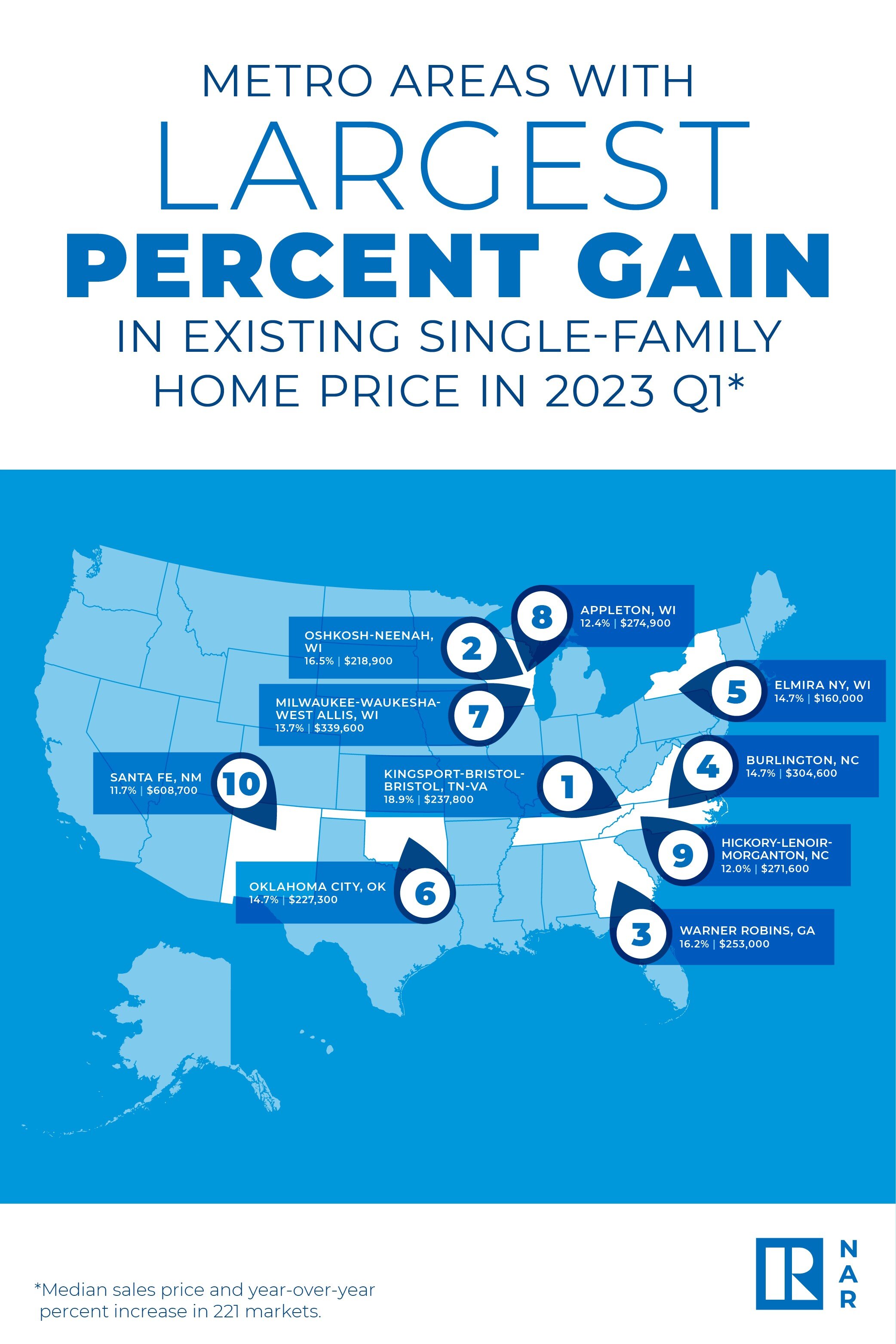Residential Real Estate News

Thirty One Percent of U.S. Metros Had Home Price Declines in Early 2023
Residential News » Philadelphia Edition | By David Barley | May 10, 2023 8:35 AM ET
Nationally, the median U.S. home price slightly dipped in Q1
According to the National Association of Realtors' latest quarterly report, nearly seven out of 10 U.S. metro markets registered home price gains in the first quarter of 2023, as 31% of U.S. markets experienced home price declines in the first quarter.
Seven percent of the 221 tracked metro areas registered double-digit price increases over the same period, down from 18% in the fourth quarter of 2022.
Compared to a year ago, the national median single-family existing-home price decreased 0.2% to $371,200. In the previous quarter, the year-over-year national median price increased 4.0%.
Among the major U.S. regions, the South saw the largest share of single-family existing-home sales (46%) in the first quarter, with year-over-year price appreciation of 1.4%. Prices climbed 2.9% in the Midwest yet slipped 0.1% in the Northeast and 5.3% in the West.
"Generally speaking, home prices are lower in expensive markets and higher in affordable markets, implying greater mortgage rate sensitivity for high-priced homes," said NAR Chief Economist Lawrence Yun.
Yun noted that cities in the West like San Francisco, San Jose and Reno saw home prices drop by at least 10% from a year ago. Conversely, prices rose by at least 10% from the previous year in cities like Milwaukee, Dayton and Oklahoma City.
"Home prices are also lower in cities that previously experienced rapid price gains," Yun added. "For example, home prices grew an astonishing 67% in three years in Boise City and Austin through 2022. The latest price reductions in these areas have improved housing affordability and led to some buyers returning given the sustained, rapid job creation in their respective markets."
Year-over-year prices in the first quarter declined by 13.5% in Austin, 10.3% in Boise and 7.3% in Phoenix.
"Due to the intense housing inventory shortage, multiple offers are returning, especially on affordable homes," Yun said. "Price declines could be short-lived."
Inventory in the first quarter averaged 1,630,000 listings at any given time, a 40% reduction from the first quarter of 2019 - a year before the onset of the COVID-19 pandemic.
The top 10 metro areas with the largest year-over-year price increases all recorded gains of at least 11.7%, with three of those markets in Wisconsin and two in North Carolina. Those include Kingsport-Bristol-Bristol, Tenn.-Va. (18.9%); Oshkosh-Neenah, Wis. (16.5%); Warner Robins, Ga. (16.2%); Burlington, N.C. (14.7%); Elmira, N.Y. (14.7%); Oklahoma City, Okla. (14.7%); Milwaukee-Waukesha-West Allis, Wis. (13.7%); Appleton, Wis. (12.4%); Hickory-Lenoir-Morganton, N.C. (12.0%); and Santa Fe, N.M. (11.7%).
Seven of the top 10 most expensive markets in the U.S. were in California, including San Jose-Sunnyvale-Santa Clara, Calif. ($1,618,400; -13.7%); Anaheim-Santa Ana-Irvine, Calif. ($1,195,500; -5.1%); San Francisco-Oakland-Hayward, Calif. ($1,192,600; -14.5%); Urban Honolulu, Hawaii ($1,029,000; -8.8%); San Diego-Carlsbad, Calif. ($880,000; -2.8%); Salinas, Calif. ($863,900; -6.8%); San Luis Obispo-Paso Robles, Calif. ($850,200; -3.8%); Oxnard-Thousand Oaks-Ventura, Calif. ($844,800; -5.6%); Boulder, Colo. ($836,900; -2.6%); and Naples-Immokalee-Marco Island, Fla. ($777,000; 4.3%).
Roughly three in 10 markets (31%; 68 of 221) experienced home price declines in the first quarter.
In the first quarter, housing affordability improved slightly from the fourth quarter of 2022 when mortgage rates eclipsed 7%. The monthly mortgage payment on a typical existing single-family home with a 20% down payment was $1,859. This represents a 5.5% decrease from the fourth quarter of last year ($1,967) but a jump of 33.1% - or $462 - from one year ago. Families typically spent 24.5% of their income on mortgage payments, down from 26.2% in the previous quarter but up from 19.5% one year ago.
First-time buyers found a small measure of relief when looking to purchase a typical home during the first quarter with the quarterly declines in prices and mortgage rates. For a typical starter home valued at $315,500 with a 10% down payment loan, the monthly mortgage payment fell to $1,825, down 5.4% from the previous quarter ($1,930) but an increase of almost $450, or 32.5%, from one year ago ($1,377). First-time buyers typically spent 37% of their family income on mortgage payments, down from 39.5% in the previous quarter. A mortgage is considered unaffordable if the monthly payment (principal and interest) amounts to more than 25% of the family's income.
A family needed a qualifying income of at least $100,000 to afford a 10% down payment mortgage in 33% of markets, down from 38% in the prior quarter. Yet, a family needed a qualifying income of less than $50,000 to afford a home in 10% of markets, up from 8.6% in the previous quarter.
Sign Up Free | The WPJ Weekly Newsletter
Relevant real estate news.
Actionable market intelligence.
Right to your inbox every week.
Real Estate Listings Showcase
Related News Stories
Residential Real Estate Headlines
- U.S. New-Home Sales Surge in August as Mortgage Rates Ease
- Despite Increased Foreign Buyer Activity, Miami Residential Sales Dip 11 Percent in August
- California Home Sales Enjoy Modest Uptick as Mortgage Rates Ease
- U.S. Home-Flipping Profits Sink to Lowest Level Since 2008 Financial Crisis as Costs Climb
- Why the World's Rich Are Flocking to Europe in 2025
- Federal Reserve Delivers First Rate Cut of 2025 as Mortgage Relief Proves Limited
- Homebuilder Sentiment Holds Steady in U.S. as Rate-Cut Bets Lift Outlook
- U.S. Mortgage Rates Experience Sharpest Weekly Drop in Over a Year
- U.S. Foreclosures Rise for Sixth Straight Month as Affordability Pressures Mount
- Black U.S. Homeownership Rate Falls to Two-Year Low as Job Losses Mount
- Las Vegas Home Prices Flatten as Listings Surge, Sales Slow
- Cooling Miami Housing Market Sees 16 Percent Annual Sales Drop in July
- U.S. Mortgage Delinquencies Uptick in June Amid Regional Pressures
- California, Florida Top U.S. Housing Markets Most at Risk of Downturn
- 30-Year Mortgage Drops to 6.56 Percent in Late August, Lowest Since October 2024
- Investors Maintain Elevated Role in U.S. Housing Market Despite Slight Pullback
- Pending Home Sales Show Mixed Signals as U.S. Buyers Remain Cautious
- Canadian Home Sales Extend Recovery in July
- U.S. Home Sales Rise in July as Buyers Gain More Bargaining Power
- Zombie Foreclosures Edge Up Across U.S.
- 2.6 Million Homes at Wildfire Risk Across 14 Western States in 2025
- One in Five Americans Willing to Trade Personal Safety for Home Affordability
- U.S. Home Price Growth Slows as Affordability Pressures Mount in 2025
- U.S. Mortgage Rates Dip to Four Month Low in Early August
- U.S. Mortgage Applications Rise in Late July, Breaking Four-Week Slump
- Hong Kong's Housing Market Stuck in Stalemate as Bulls and Bears Face Off
- U.S. Condo Market Struggles in 2025
- U.S. Pending Home Sales Remain Sluggish in June
- Los Angeles Area Wildfires Destroyed Nearly $52 Billion in Homes Last January
- Greater Palm Beach Area Residential Sales Slip in June Amid Growing Inventory
- Economic Resilience Lifts U.S. Housing Outlook Going Forward
- New Home Sales Stagnate as Affordability Struggles Continue in America
- U.S. Housing Market Slips in June as Prices Hit New Highs
- Florida, California Continue to Reign Supreme as America's Ultraluxury Housing Markets
- Caribbean Housing Market Evolves into Global Second-Home Hotspot
- U.S. Home Sales See Highest June Cancellation Rate on Record
- Orlando Housing Market Cools in June as Listings Slide, Sales Slow
- Private Credit Surges in 2025 as Real Estate Developers Bypass Banks
- U.S. Condo Market Suffers Sharpest Price Drops in Over a Decade as Buyers Retreat
- Rising Taxes, Insurance Costs Undermine the Stability of U.S. Homeownership








